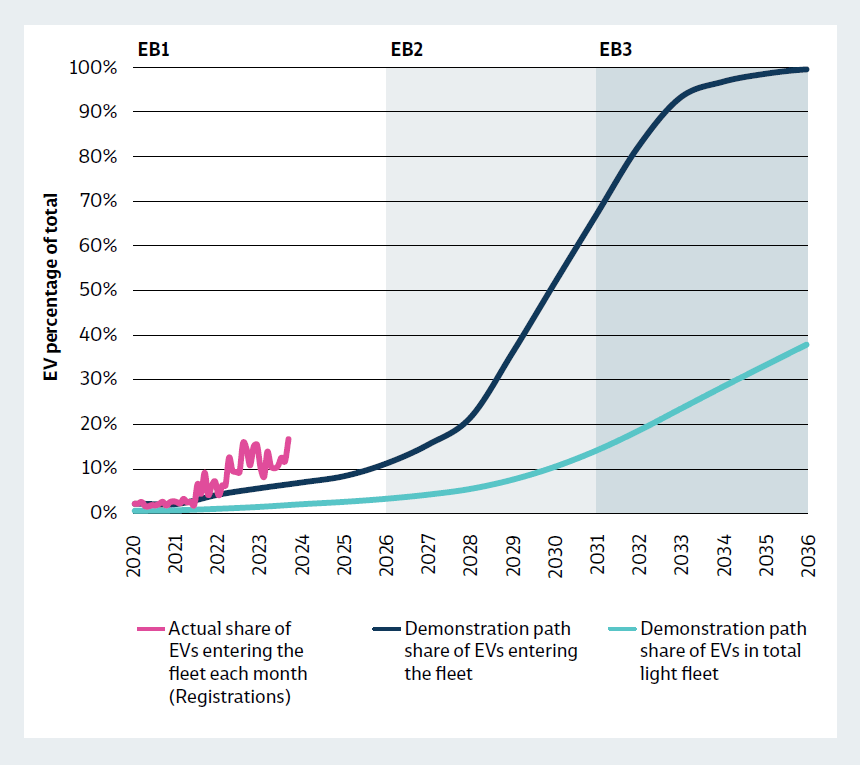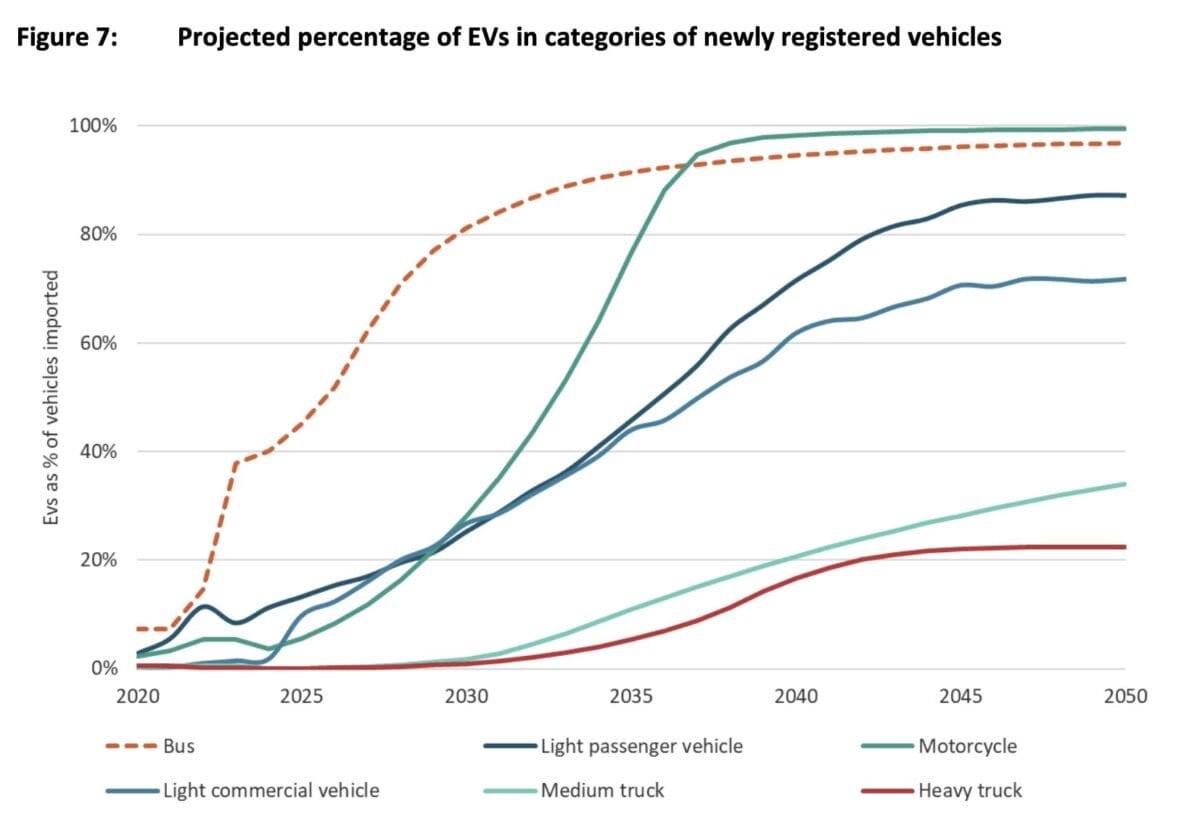What are New Zealand’s EV Targets?
According to the Ministry for the Environment, “two-thirds of transport emissions come from the light vehicle fleet.”
The light vehicle fleet includes all passenger cars, utes, and vans under 3,500 kg (Gross Vehicle Mass – GVM).
Various policies have been implemented (and removed) that have affected EV uptake in New Zealand.
First target: 64,000 EVs by 2021
The National government set the first primary target for EV uptake in May 2016. Several initiatives were undertaken to have 64,000 EVs on the road by the end of 2021.
In reality, just over 36,000 EVs were on the road by the end of 2021.
Despite the plan to address Fringe Benefit Tax rules, no changes were made – missing out on early EV uptake by corporate fleets. However, NZ passed the 64,000 mark in December 2022 due to the Clean Car Discount implemented (ironically) by the Labour government.
Climate commission target: 100% market share by 2035
Transport plays a major role in New Zealand’s goal of reaching net zero carbon emissions by 2050.
The Climate Commission report (April 2023) made some projections:
“From 2025 to 2030, our demonstration path sees annual light EV registrations climb from 11.5% to 67% of the market and reach 100% percent by 2035. This means 100% of cars entering the Aotearoa New Zealand fleet, whether new or new second-hand imports, are electric in 2035.” (source)
The Climate Commission sets ‘budgets’ – a target for allowable emissions over 5 years. Here is their modelling for EVs in the fleet.
- EB1 2022-2025
- EB2 2026-2030
- EB3 2031-2035

Actual EV market share of all light vehicles.
Emissions Reduction Plan (2022): 30% zero-emission vehicles by 2035
The Emissions Reduction Plan is the strategy on how to meet the emissions budget. The first reduction plan (May 2022) set this target:
Target 2 – Increase zero-emissions vehicles to 30 per cent of the light fleet by 2035.
This is a very ambitious target. It would require around 120,000 zero-emission vehicles to be added per year (and the same amount of combustion vehicles must leave the fleet).
Emissions Reduction Plan (2024): No targets, install more chargers
The second Emissions Reduction Plan (December 2024) contained very few plans to reduce emissions in the transport sector.
Install 10,000 EV chargers by 2030
The plan is to facilitate private investment to increase the number of public EV chargers. How this will lead to reduced emissions is unclear. The modelling document says:
“The effects of 10,000 public EV chargers are based on conservative assumptions in the absence of suitable empirical evidence to base any assessment on.” (p 34, source).
Revise the Clean Car Importer Standard
The most ironic ‘reduction plan’ is revisions to the Clean Car Importer Standard. The new revisions (enacted in 2024) reduce emission targets for commercial vehicles, leading to more emissions.
This is confirmed by the ERP:

These show an increase in emissions in future years.
ERP projections
From the Technical Annex Dec 2024

Clean Car Discount (from 2021-2023)
Enacted in 2021 by the Labour government, the Clean Car Discount introduced a series of rebates and fees on newly registered light vehicles in New Zealand. The rebate could only be claimed on the vehicle’s first registration in NZ.
The policy had a significant (and somewhat chaotic) effect on the New Zealand vehicle market.
The newly elected National government cancelled the scheme at the end of 2023, and implemented Road User Charges on electric vehicles in April 2024. These policy changes heavily impacted the EV market – leading to a very quiet year for EV sales (against the backdrop of recessionary economic environment).
Stage 1
1st July 2021 – Rebates for battery EVs and plug-in hybrid EVs.
| 1/7/21 – 31/3/22 | New vehicles (under $80k) | Used import |
| BEV | $8,625 | $3,450 |
| PHEV | $5,750 | $2,300 |
Stage 2
1st April 2022 – The scheme was extended; rebates were available on hybrids and low-emission petrol vehicles (less than 146g/km CO2. The rebate amount was dependent on the emissions level. Fees were introduced for high-emitting vehicles (more than 192g/km CO2).
Stage 3
1st July 2023 – The scheme was adjusted; the criteria for low-emitting vehicles were tightened. The fee-paying threshold was lowered to 150g/km CO2. Rebates were only available where emissions were under 100g/km CO2.
| 1/7/23 | New vehicles (under $80k) | Used import |
| BEV | $7,025 | $3,507 |
| PHEV | $4,025 | $2,012 |
End of Clean Car Discount
31st December 2023 – The newly elected National-led government ended the scheme.
Clean Car Importer Standard Targets
The Clean Car Importer Standard sets progressively lower CO₂ emissions targets for vehicle importers (both new and used). The targets were adjusted in 2024 (light commercials – utes and vans – had targets lifted upwards).
The system uses credits and penalties to help importers sell more lower emitting vehicles. Importers earn credits for vehicles below the target and face penalties for vehicles that exceed it.
Type A is for passenger cars, while Type B is for light commercial vehicles (utes and vans). Numbers are grams of CO₂ per kilometre
| Year | Type A | Type B |
| 2025 | 113 g/km | 223 g/km |
| 2026 | 108 g/km | 207 g/km |
| 2027 | 103 g/km | 175 g/km |
| 2028 | 76 g/km | 144 g/km |
| 2029 | 65 g/km | 131 g/km |
References
- Drive Electric published a paper by Concept Consulting showing that if the Clean Car Discount were removed, there would be 350,000 fewer EVs on the road by 2030.
- EECA made a submission to the Climate Change Commission in 2021. It said: “50% of light vehicle imports will be electric by 2027, with 40% of the fleet electric by 2035.”
- Emissions Reduction Plan 2024.
- Emissions Reduction Plan 2024 – Technical annex.
- Explanation of Australia’s NVES – implemented 1/1/2025
